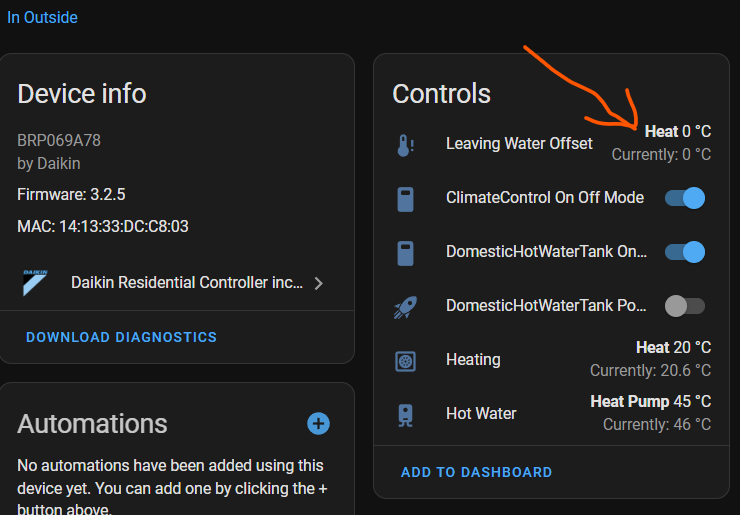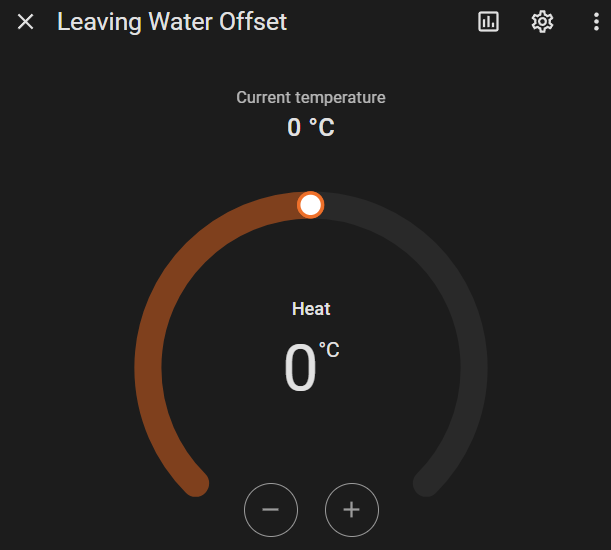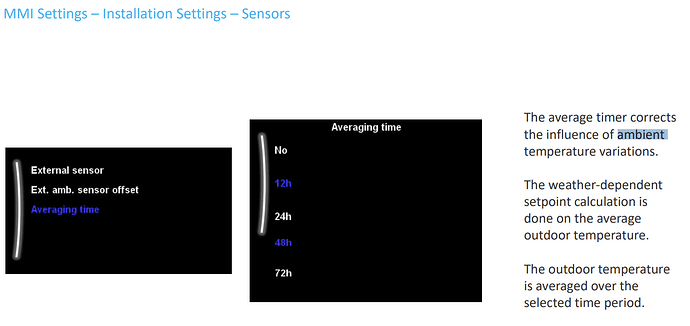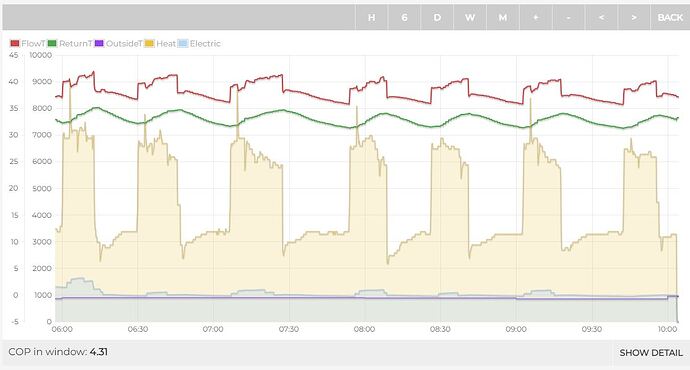I’ve seen it too - especially when the sellers are a group company, and even when they tell bare-faced lies in order to look better than a more competent supplier from outside the group. (I’m not intending to even imply that Daikin might do this - the company I have in mind and experienced no longer exists.)
Thanks… I was looking at this the other day… I have half a mind to experiment with a software thermostat and the Daikin just set to leaving water temperature control.
What’s the best way to install this integration in Home Assistant, when I already have the other “Daikin Residential for Altherma 3” integration installed? (I know how to add a custom repository.) Should I remove the currently installed integration and then install the new fork?
yes, do a backup 1st, so you have a rollback plan, then remove the HACS original integration and manually install the fork (it’s the same dev, but the fork does not rely on another contributor, he is a nice guy (HACS on the way) and I have sponsored his efforts), install the ‘samba share’ add-on and copy the repo via file explorer, restart, and add back the integration, it’s not too difficult, note the sensor names changed.
The system has been working really well at an outside temp of ~2 with my flat ish WDC, so my thinking is for uber efficiencies outside this operating window, I can ‘automate’ and add some external non-daikin logic and control while not screwing up the system and just using an offset, so, if the house either does not cope with high or low shoulder temps. eg
eg
if outside temp is <2 (based on multiple sensors)
set offset +1 (via the cloud API integration)
else
set offset 0 (via the cloud API integration)
and the reverse
if outside temp is >8
set offset -1
else
set offset 0
Maybe run the automation every ~60 mins, so not to make loads of API calls, and continuous variation within the HP’s own logic.
Values TBC based on experimentation; I have no idea yet :-), would be good to get any feedback from others who use the offset paradigm.
I use Node Red for my automations and visually easy to apply intention and logic.
hope this makes sense?
Personally, (caveat - with the right sized system) I think it’s best to let the Daikin manage itself with the Madoka and modulation, but influence the offset, again without being to intrusive from the intention of the manufacturers design or operation and years of experience with predetermined parameters that I guess fit 80% of use cases and houses.
I think modulation is meant to influence the offset, but we have not gotten cold enough yet for me to notice any real results, we are currently at a steady ~30 degrees LWT and ok to maintain room temps. However, it did change from~29 to ~31 either side of the DHW cycle, maybe it’s working but very subtly?

You can change the sample size of the ambient outside temps, this may slow down the modulation and change of the LWT. way too many Daikin parameters to tweak ![]() (ours is set to ‘no’)
(ours is set to ‘no’)
I seem to have found the sweet spot for my 9kW Daikin Altherma 3
23c indoors and freezing outside, flow temperature of 32c and less than 1kW of electricity.
COP is high 3’s
Minimal defrosting although the humidity is lower than it was at the beginning of December when it was this cold.
Perfect, I don’t even have any windows open now.
One more bonus is that it is now entirely solar powered on a day like today.
This is close to my design parameters from Octopus in terms in inside and outside temperatures.
The only difference is that I am doing it at 30c flow instead of 50c flow thanks to properly sized radiators.
The only thing I am puzzled by now is how I am managing to maintain 23c inside (even in my conservatory) when it is zero outside using on an average 3.8kW of heat?
That is half my heat loss of 7.6kW `calculated’ by Octopus, a bit of a puzzle???
So my new control strategy is to reduce the flow temperature as the outside temperature reduces to maintain electricity input of less than 1kW.
A manually operated reverse weather dependent curve!
Matt seen your stats and I seem to be having the same problem as everyone else can you possibly share your settings with me to try as a base line D/T, modulation, overshoot and pump restriction etc Have uprated all my radiators to K2 and removed pipework restrictions.
Matt, I’m doing something similar - I’m running full LWT/weather compensation and monitoring heat produced, external temp and internal temp. We are keeping a pretty consistent temperature. Overnight we have a setback of -3 on the schedule to “cool” the house. Unfortunately, above 5 degrees it does nothing - temp stays constant!
In Tado I get multiple temps for the day so averaging those over the day.
Is the following correct in working out HL?
const heatTransferCoefficient = 1.0; // varying this to see impact
const heatProduct = 159 * 1000; // to watts
const temperatureDifference = insideTemp - outsideTemp;
const hourlyHeatLoss = (heatProduced / hoursInDay) + temperatureDifference * propertySize * heatTransferCoefficient / hoursInDay;
return Math.max(0, hourlyHeatLoss / 1000);
are you restricting the pump at all and what delta t are you using
nick
deltaT of 5.
No pump restriction we have a fully open system. UFH downstairs & rads upstairs.
I have overshoot of 4. Modulation only applies when using the Madoka thermostat - rather than LWT.
Hi Nick and David,
I will tell you my settings but there are some important factors to take into consideration that influence why I do what I do.
My house is quite small, 98m2 with a 13m2 conservatory, it’s all glass but the heat loss is not massive but more than the rest of the house by floor area.
I have 40kW of radiators (at dT 50c) as that is what you need to deliver the full minimum output of this heat pump. This based on a COP of 5.0 flowing at 35c when it is 7c outside.
As my house is quite warm, it is always 23c downstairs and 21c upstairs I am pushing the limits of my radiators at the low flow temperatures due the the dT between the mean flow temperature and the room temperature.
I don’t pay for my electricity from my earnings from work, it all comes from payments from exported electricity. I know it is still money but I don’t view it in quite the same way and the aim is just to never exhaust the credit on my account, as long as I never have to actually pay anything I am not really bothered.
I have 13.5kwp of solar panels and 38kWh of usable battery storage. Most of my imported electricity comes from the cheap six hours on Cosy Octopus.
As I run from batteries most of the time my aim is to keep my instant power draw by the heat pump as low as I can as that frees up the battery discharge capacity for other things.
I want low and slow heat, for the batteries, because I like it and because the conservatory really needs it, it cools down faster than the rest of the house.
This means I don’t like the Madoka or any other form of room thermostat controlling when I get heat.
Using the Madoka I get 90 minutes of heat and 150 minutes with nothing, my electricity use is lower but only by about a third as the heat pump has to work harder when running.
So I am prepared to pay the price of running the heat pump practically constantly, it doesn’t cost me too much and the house is more comfortable.
As my house is so small and the heat loss is less than 5kW at my design temperature I never need more than the minimum output so I am always just trying to get the electricity consumption as low as possible, that means I end up turning the flow temperature down when it gets colder.
This usually has no effect, below about 37c flow makes no difference to energy consumption, a higher flow temperature just increases the heat output and the COP. So I use the flow temperature to control the electricity input, I raise it when it’s warmer outside and drop it as it gets colder always aiming for 900w input and the fastest heat up.
The heat up seems to be timed, the flow rate remains at the highest level for a set time and then reduces.
I have also noticed that the maximum run time is limited to 6 hours, it will always defrost and start again from scratch once every six hours if no other defrosts were required.
I don’t use a WD curve, I have tried, but I really need it to work the opposite way around.
I hope I have explained why I run what I do and that it makes sense, at least in part.
So my settings.
I run fixed lwt and adjust as necessary to either increase heat output and/or control electricity consumption.
If the house gets to hot I open windows and the internal door to our garage, I even have to open the windows in the conservatory at times, but it works as explained above.
I have an overshoot of 4c
I run the emitters as radiators, I have found it gives the best performance in my house. The heat pump is always looking to get to a dT of 8c, it uses the least pump power and gives me the best heat output for the electricity consumed.
I rarely get to a dT of 8c but it is usually around 6.5c.
I normally have lwt at 36c but it never really sits there, it seems to always settle around 34.5 to 35c, I don’t know why.
I turn it down to 32/33c flow when it is near freezing, at this point the windows are closed and the heat output perfectly matches the heat loss of the house, about 3.8kW over the last few days.
I was looking for a way to try and run more effectively in shorter heating runs, I have always found the initial 60 to 90 minutes quite poor for efficiency plus consuming more electrical power than I would like.
So, I can’t remember who pointed me in the right direction, but I found that the pump speed could be limited to 60%, it’s in the menu where I knew to limit the pump speed on sampling but if you scroll up in the menu it can be limited all of the time.
This does not affect DHW or defrosts from what I can see, just heating.
At 60% the start up is much better, flow rate only goes to 15lpm and the drop down to 10lpm is more gradual and doesn’t seem to shock the system as it did without the limitation.
The first time I tried it I was using the Madoka. Set at 22c it usually ran the heating between 21.6c and 23.5c, the same as I think we all see.
With the pump limited the heat output built so quickly that the Madoka turned the heating off at 22.5c.
I think the pump limitation works for me and my heating system.
For me, when it is cold this heat pump is really good, it’s not working very hard and heats the house with no fuss and never drops below a COP of 3.
I can leave the house unheated for hours and it heats up almost immediately, it’s very similar to the gas boiler it replaced.
But that’s all because it’s way too big for my house.
I don’t know how big Nick and David’s houses are but I know David has the 16kW, I would imagine David’s house is big enough to make better use of what I think is actually quite a nice heat pump.
The only mistake Daikin have made is not giving them all a similar range of operation, basically we all have the same heat pump until we need more than 9kW of heat.
some great information and reasoning I’m about 155m2 plus a conservatory been trying a few things but never altered the overshoot has always been 1 will have a try of your setting see how I get on not using modulation and room thermostat. So do you set your DT to 8 then?
Hi Nick,
When you change the emitters to radiators the dT is fixed at 8c.
When I was using the Madoka I tried modulation over the full range but eventually turned it off.
I did use it when I had smaller radiators and a higher flow temperature and it worked well at about 2c.
Whilst I find the Madoka doesn’t work for me in this house that doesn’t mean I think there is anything wrong with it.
It is just my house will behave differently to what the Madoka thinks is needed, it is not designed to cope with a heat pump of this power in a house this small with this low a heat loss, my house just gets hot much quicker than it is expecting.
The Madoka is supposed to adjust the performance of the heat pump based on what the house needs, I just think I am beyond its operating scope.
With regard to radiators, I have no zones and no trvs for the obvious reasons.
I replaced all my trvs with Danfoss RLV-D lock shields.
One other thing I forgot, I also have Speed comfort fans on all my downstairs radiators. They run continuously as my radiators rarely get hot enough to turn them on with the included temperature sensors.
This doesn’t look right. What is heatProduct and why isn’t it used? Are you trying to work out net heat loss rather than how much heat is required?
I suggest working out the heat transfer coefficient for the property by following this article: Cold Weather Measurements of Heat Transfer Coefficient | Protons for Breakfast - this will give you W/K plus a base heat from appliances and humans. For example, my property is 260 W/K + 880 W.
You can then do temperatureDifference * heatTransferCoefficient + baseHeat to get how much heating power you need to maintain the temperature of the property. Multiply by hoursInDay to get daily kWh, and compare that to how much is being produced by the heat pump.
Sorry Tim made a mistake:
const heatTransferCoefficient = 1.0; // varying this to see impact
const heatProduced = 159 * 1000; // to watts
const temperatureDifference = insideTemp - outsideTemp;
const hourlyHeatLoss = (heatProduced / hoursInDay) + temperatureDifference * propertySize * heatTransferCoefficient / hoursInDay;
return Math.max(0, hourlyHeatLoss / 1000);
I’m trying to do the inverse of what you are suggesting. I’ve got the kWh produced by the HP, and trying to work out the relevant HL that way.
I’ve just realised that the calculation for kWh is out.
The 159 is kWh of heat produced from the Daikin.
Thanks for the link - so all I need to do is a Heat produced / 24 from reading ![]()
That will give you average power (W). To get the coefficient, divide by temperature difference to get W/K.
A simpler method is to calculate temperature difference as max(0, 15 - outsideTemp) on the basis that heating isn’t usually required at all on milder days, due to residual heat. Divide daily kWh by temp diff over several days and take the average, will be reasonable approximate.
3 posts were merged into an existing topic: Thank you OpenEnergyMonitor: Octopus Daikin ASHP monitoring
It’s working within it’s design envelope - between 4 and 9kW, and the house can dissipate the energy, so it’s happy!
It’s the same here, above COP of 3 for a change.
Exactly right, it is only ever happy putting out 4kW+
If you need or want less it comes at the price of lower efficiency.
It is in essence the problem with this heat pump.
Just as a beacon of hope here.
Octopus following a few calls agreed to swap my EDLA09DA3V3 to the EDLA08E2V3.
This did not go smoothly and their own electrician broke the OEM electric meter and the spare I had (so had to get a replacement).
However, I am happy to report that the 8kw is frugally sipping away at the electric and for the two days of monitoring (Farnborough, Hampshire) we have a COP of 3.9 and 3.6 the figures being almost identical to the install by Adam from heat geek (Mytchett, Surrey) for the days in question.
I did get my own independent heat loss survey and used heat punk to model the install. I also had to provide octopus with the exact radiator swaps that needed to happen as their design team wanted to make lots of other changes based again on a less than accurate heat loss survey (first one forgot the loft insulation, second one seemed to have assumed insulatiin between floors, there is none).
The COP should improve slightly more once the radiators are installed (as they are currently on backorder) and I have balanced out the system but the design temperature of 40@-2has likely helped a bit too.
Thanks for all of your help from discussions and other reviews of this dragon of a pump and if you can get it swapped out by your installer then there is hope for it to work.
Just be aware that you may as well have the 08 unit as the 4 & 6 are again software derated and you are not likely to see any additional bottom end performance and will only limit your maximum ability to reheat the house and DHW.




